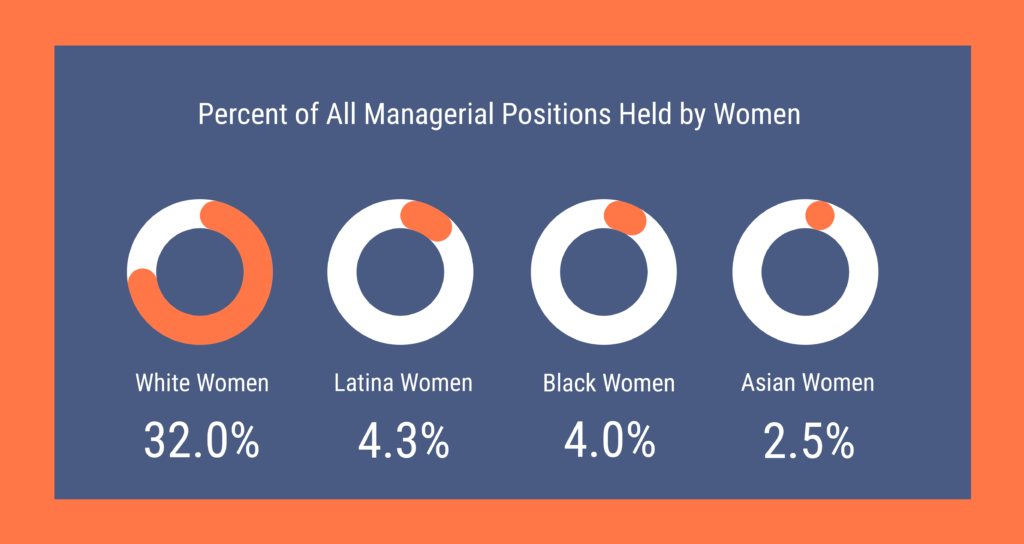
Adobe works to expand the talent pipeline by partnering with Historically Black Colleges and Universities (HBCUs) to provide learning and career opportunities through mentorships and financial and other support programs.
Konica Minolta launches its Step Together program to empower women in its dealer channel and joins more than 2,400 company heads in signing the CEO Action for Diversity and Inclusion pledge.
Bank of America marks 2023 as its third year of improving the advancement of underrepresented groups, with BIPOC and women receiving more than half of its new manager positions.
All Fortune 100 companies now have implemented Diversity, Equity, and Inclusion (DEI) policies and programs, and overall U.S. companies of all sizes are adopting DEI initiatives, which can promote a wider range of perspectives, enhance creativity and innovation, and positively impact business performance. Diversity hiring drives innovation, growth, and profitability.
McKinsey found, for instance, that companies in the top quartile for workforce ethnic and cultural diversity outperformed those in the fourth quartile in profitability by 36 percent, an increase of 3 percent in two years. When adding in gender, companies in the fourth quartile were 27 percent more likely to underperform.
Notably, companies that have carved out large budgets for inclusion and diversity and gone beyond dry checklists to actively hire, train, retain, support, and promote a diverse workforce have demonstrated success.
If creating a diverse sales team and an inclusive workforce is an advantage, what does it take for companies to achieve diversity? Here, we explore how companies can evaluate their hiring process and renovate their corporate culture to boost employee engagement and positively affect the bottom line.
Match Perception with Reality
Ask chief sales officers, and 84 percent say they are satisfied with the gender diversity of their sales leadership team, Gartner found. Yet, data shows:
- Women represent globally 4 in 10 of entry-level sales employees, only 23 percent of sales representatives, and only 15 percent of front-line sales managers.
- White women hold 32 percent of all management positions, while women of color hold a dramatically lower share: Latinas 4.3 percent; Black women 4.0 percent; and Asian women 2.5 percent.

A flawed business plan develops when perception clashes with reality. Think of it this way: “If you knew of a strategy that increased the bottom line and you weren’t doing it, as a leader, that would be unacceptable,” said Sharon Melnick, business psychologist, best-selling author, and founder of the Next Level Leader initiative for coaching mid-career women.
Hiring and supporting advancement in the name of diversity predicts financial success and improves financial performance and should be a part of best practices. “If you have different kinds of people, you are going to have more innovation,” said Linda Dunbar, CEO of Diversity Decoder (New York), which supports companies to successfully strategize and implement organizational and employee DE&I plans. Dunbar has a corporate communications background, working with senior leadership of both global Fortune 500 and entrepreneurial businesses.
Educate and Involve Leadership in Diversity Hiring Process
Top-level leadership — the chief executive officer (CEO) and the entire C-suite, and perhaps even the board of directors — must participate in diversity hiring efforts and the education process for any organization. “There should be no hiring a chief diversity officer and handing it off to them,” Dunbar said. Leadership must create the structure and the strategy for organizational implementation of diversity policies, and then either participate and drive the policy or otherwise endow the chief diversity officer with substantial authority.
Mid-level managers are key to creating an inclusive workplace and maintaining ongoing, honest conversations about performance and company culture that breed a lack of diversity. “Even when the executive team is fully committed, employees working under a less-than-committed direct manager are far less likely to feel welcome and included — and far more likely to leave for a job elsewhere.” Mid-level managers have a specific impact on team performance and need continuous training that is currently lacking in most companies, Dunbar said.
Expand Recruitment Channels
“Too often we hear, ‘They are not out there. We tried,’” Melnick said, in response to recruiting diverse hires. “That’s an indication your networks are too narrow.”
If recruitment is centered on the networks and referrals of a white male management team, you are not connecting to potential employees of color, women executives, or diverse backgrounds, Melnick said. The question at this point is, how can you source different people?
There are more than 30 Black professional associations, for example, and as many professional associations of women, Asian-Americans, and other sectors of the population and industry-specific associations of those populations. There are Historically Black Colleges and Universities (HBCUs), Hispanic-Service Institutions (HSIs) represented by the Hispanic Association of Colleges and Universities (HACU), and other institutions and associations that focus specifically on minority outreach.
“Companies should definitely be making partnerships with them,” Melnick said.
Following social media pages, signing up for email alerts and newsletters, attending events, and setting up coffee meetings are all ways to expand your network — and awareness.
Reevaluate the Diversity Hiring Experience
What do sales organizations do to win over customers? They personalize the experience and work on continually improving it. For companies to move ahead in diversity, they need to make the same commitment to challenging basic hiring practices, Dunbar said — as if your candidate is your customer. You have to ask, “What is the customer experience for the candidate?”
Interview questions. Crack open your thinking about interviews, Dunbar said. If the goal is to hire a diverse sales team, how do the questions you ask in an interview:
- Evaluate, and value, experience and knowledge?
- Perpetuate a culture of sameness in the name of cultural “fit”?
- Engender judgment?
Even questions about hobbies can embed assumptions, Dunbar said. “I may prefer pottery, which may be less corporate” than golf or baseball, Dunbar said. “How might you judge me when I tell you that?”
Subjective vs. objective criteria. Hiring committees should be challenged to develop clear, operational, objective criteria for evaluating candidates, Melnick said, which cuts down on the subjective “he looks like me,” “he’s in my golf community,” or even the more commonly used “he’s a good fit.” When hiring committees say a person is a “fit,” it should be based on a common definition that candidates can be gender- or color-blinded against, Melnick said.
Images and word choice. Examine the way roles are talked about in all your materials, Melnick said. Women are less engaged and motivated to apply for a position when the recruitment experience celebrates a specific in-office culture rather than an environment where diverse types of participation thrive. Similarly, if the job description features male-centric qualities, using words such as “aggressive” and “competing” versus “customer-focused” and “succeed,” they can alienate women candidates, Melnick said.
“When it comes to women in sales, emphasizing problem solving and relationship building can be more appealing,” Melnick said.
A wider palate. In a review of more than 20 million business profiles, one study found that women and minorities have unique ways of describing themselves and are more reserved in listing skills; women’s profiles listed 34.2 percent fewer skills than in the baseline average. As such, traditional candidate sourcing can promote and reward the approaches of non-diverse candidates and talent. If you want to hire more diversely, look for reasons to include rather than exclude candidates, Dunbar said.
Focus on Retention, Create a Path for Advancement
The cost of replacing a worker is roughly 20 percent of their salary. But lack of advancement opportunities, or encouragement to do so, is a primary reason for women and multicultural hires to leave. Even when specifically recruited, because of cultural factors at organizations, they don’t always thrive, Melnick said.
For six years in a row, McKinsey reported the “broken rung” for women and especially women of color was still intact: For every 100 men promoted to manager, there were only 85 women; only 58 Black women; and only 71 Latinas promoted. By 2020, men held 62 percent of manager-level positions, while women held only 38 percent.
There has to be awareness and a willingness by companies to support change and nurture talent, Melnick said, if nothing else for a better bottom line.
In B2B sales, women make up only one-third of the sales force, but achieved quota at higher rates, 86 percent, than compared to men, at 78 percent. Higher up the chain, firms with greater gender diversity among C-suite leadership perform better because women’s approaches to innovation led the way for “a wider variety of strategies for creating value.”
“When women have greater opportunity, there is greater engagement in a company’s culture by both genders,” Melnick said. Those cultures are associated with an increase in employee engagement, productivity, and profitability. “When people feel valued, with opportunities to express their full talents, it is motivating and feeds a sense of mobility and opportunity for everyone.” The nature of sales is changing, Melnick said, and increasingly, the biggest value is not the initial sale but the long game of developing relationships over time; adding to the value proposition; and thinking in context — all qualities that play to women’s strengths. “There is something in women’s approach to sales that can improve the overall sales approach,” she said. “Women’s approaches are proving effective.”

Diversity hiring is not only the right thing to do, it is the smart way to conduct business, particularly as sales organizations scale their teams. Hiring sales professionals from diverse backgrounds, with varied lived experiences, brings a wider range of ideas, knowledge, and approaches to problem solving. By building a reputation for valuing differences, you will have greater commitment, higher productivity from your employees, and better long-term viability in today’s work environment. Millennial and Generation X job seekers rank workplace diversity as a top-three priority, and are likely to stay nearly five years, almost twice the average 2.8 years, in a company that fosters DEI. As customer expectations continue to evolve, attracting and retaining a diverse sales team will be key to future sales workforce successes.
“If you’re a business owner of a start-up or a company that is going to be sold at some point, you need diversity,” Dunbar said. “If your company is dependent on 50+ aged white men, who is going to be buying that? You need to think of diversity as an exit strategy.”
As you look at your diversity hiring program, ask yourself:
- Who is visibly underrepresented among your sales representatives, managers, and leaders?
- What immediate steps and long-term goals can you develop to promote diversity hiring in your sales organization, and how do they fit the needs of employees, customers, and investors?
- How do you integrate diversity tactics into the everyday fabric of your organization’s mission and goals through mentorship, coaching, and the advancement of underrepresented populations?
- How can you efficiently achieve these goals and measure the benefits?
Looking to Start Diversity Hiring Today?
At DANA Associates, we know the more well-rounded and diverse your team, the better equipped your company will be to develop new solutions and thrive. Whether you’re building your sales team from the ground up or bringing on new sales leadership, DANA Associates has the individualized approach for finding the diverse sales team and candidates you need. To learn more, schedule an introductory call today.

